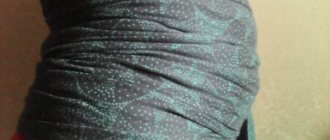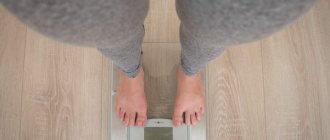“Space diet” by Sergei Sivokho: without denying himself anything, the comedian lost 42 kg in 3 months
There are many different methods for losing weight, for reducing the waist, for tidying up the abs, reducing excess fat, etc. But only vacuum exercises for the abdomen allow you to achieve quick results in a minimum of time and for a sufficiently long duration.
How does a vacuum work after a caesarean section?
Vacuum after cesarean section is an exercise that is specifically designed to eliminate a sagging, protruding abdomen. In principle, it is suitable for any weight loss, even if there is no history of caesarean section.
Its versatility is ensured by the principle of influencing the body in general and specifically the abdominal muscles:
- during inhalation, the abdominal muscles tense as much as possible;
- they remain in this tension for several seconds;
- During exhalation, the muscles do not relax, but are held by force in a tense, constrained state.
The result of such forceful action will be increased blood circulation specifically in the abdominal area, maximum saturation of tissue cells with oxygen. This ensures faster metabolism at the cellular level. The more muscles work, the faster they strengthen and tighten.
We recommend reading the article on how to remove belly fat after a caesarean section. From it you will learn about the causes of a large belly after surgery, how long it takes to recover, how to remove belly fat at home, and also with the help of surgery. And here is more information about how long after a cesarean section you can play sports.
The benefits and harms of abdominal vacuum after cesarean section
The benefits of vacuum exercises for the abdomen after cesarean section are as follows:
- the abdominal muscles are strengthened, due to which it tightens and does not bulge;
- the appearance of the skin improves - it becomes firmer, its elasticity is restored, and sagging disappears;
- intestinal function is normalized by stabilizing peristalsis;
- the ligaments that hold the internal organs of the abdominal cavity in an anatomically correct position are strengthened.
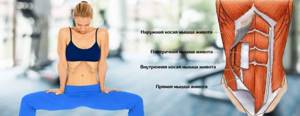
In addition, with regular training of the abdominal muscles, existing fat deposits are burned, and this ensures overall weight loss. If the exercise is performed in a sitting or standing position, then at the same time the back muscles will be strengthened - the usual pain in the lower back, in the area of the shoulder blades, will disappear.
If the exercise is performed strictly after the doctor’s permission, then it cannot cause any harm to health..
Techniques of professional massage therapists
If a specialist performs a postpartum abdominal massage for you, he will begin the session with soft and rhythmic strokes, which can be straight or wavy, longitudinal, transverse or zigzag, superficial or, on the contrary, deep. Then, in turn, there will be rubbing and kneading, impact techniques (tapping and patting, chopping and sawing) and vibration techniques.
Table: basic massage techniques, effect of exposure
| Massage techniques | Effect |
| Stroking |
|
| Rubbing |
|
| Kneading |
|
| Striking techniques |
|
| Vibration techniques (final) |
|
Cosmetics for the procedure
Massage therapists use creams and oils to improve the glide of hands over the skin. In addition, these products can have different effects on the skin and subcutaneous layer.
Abdominal massage can be done:
- with talc or baby powder - used very rarely, as it is believed that these products get into the pores, preventing them from being cleaned;
- with baby mineral oil - for example, Johnson's Baby or others;
- with vegetable oil - preferably olive oil, as it is well absorbed, has an unobtrusive odor, and promotes better heating of the massaged areas;
- with vegetable cosmetic oils - peach, grape seed, shea butter, avocado, almond, etc. - they nourish and moisturize the skin, but before using them you must conduct an allergy test;
- with any essential oil, only if the woman is not breastfeeding and has no allergies (be sure to do a test) - orange accelerates the metabolism of fats and carbohydrates, lavender relieves muscle tension, lemon helps eliminate toxins, affects cellulite, strengthens local immunity.

Essential oils should not be used for belly massage if you are breastfeeding.
Is it always possible to do a vacuum after a caesarean section?
It is strictly forbidden to make a vacuum after a caesarean section if:
- heavy menstruation, which is accompanied by pain in the lower abdomen;
- frequent dizziness;
- unstable blood pressure (hypertension or hypotension);
- infectious diseases occurring in acute or chronic form with frequent relapses;
- headaches of unknown origin;
- diseases of the kidneys and urinary system;
- diagnosed benign formations in the body of the uterus, including polyps and cysts;
- confirmed malignant tumors, regardless of their location in the body.

Conditional contraindications include: fever, acute respiratory viral diseases, exacerbation of chronic pathologies of the gastrointestinal tract. You can begin such physical activity only after your health has been restored.
Undeniable advantages
Before mastering this miracle exercise, it would be good to understand what benefits it will bring to new mothers:
- during exercise, the internal organs do not move, so you don’t have to worry about hernias and prolapses;
- regular exercise will reduce the volume of the stomach, which will have a positive effect on weight loss (read how to lose excess weight after childbirth in other ways);
- the elasticity of the skin will improve, which means stretch marks will become less noticeable, and sagging will decrease, in addition, blood flow will restore the condition of the skin that worsened during pregnancy - it will become velvety, elastic, beautiful, and the fat balance will stabilize;
- will speed up the process of restoration of internal organs after childbirth;
- when the pressure in the peritoneum decreases, the outflow of venous blood increases, which reduces the risk of hemorrhoids and varicose veins;
- relaxes the pelvic floor muscles, which is valuable after ruptures.
If you perform a vacuum before birth, the birth of your baby will be easier and faster.
One of the obvious advantages of a vacuum is its static nature, which does not involve intense training as in aerobics or fitness. Let me remind you that heavy physical activity is undesirable after the birth of a baby, because it can lead to diastasis.
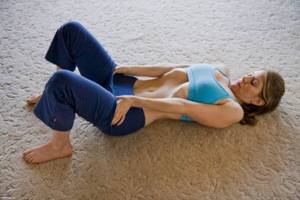
Regular exercise will also remove excessive stress from the spine. Your posture will improve, your lower back will stop aching, your gait will acquire prenatal lightness and elasticity.
In addition, vacuum:
- strengthens the transverse muscles that support the internal organs;
- will reduce the volume of the abdomen;
- will accelerate the burning of visceral fat - the most dangerous for the body;
- improves gastric motility and digestion;
- will speed up metabolism, which will lead to weight loss;
- enriches all tissues and organs with oxygen.
When to start: optimal time
Immediately after a cesarean section, any physical activity is contraindicated, so you should start performing the vacuum exercise to get rid of a bulging, sagging belly only taking into account the following doctor’s recommendations:
- If the operation was successful and the early rehabilitation period proceeded without complications, then physical activity on the abdominal muscles can be given only 3 months after childbirth. Begin classes in a daily mode of 3 approaches, each of which lasts 10 seconds maximum. It is better to limit yourself to 2 approaches so that there is no excessive tension on the muscle fibers and skin.
- In case of complications during the rehabilitation period after a cesarean section, such as inflammation with the formation of purulent exudate, cleaning the uterus from accumulated blood clots, or inflammation of the suture, any sports activities are postponed for at least 12 months.
Watch the video on how to make a vacuum:
In any case, childbirth by cesarean section makes it necessary to constantly monitor the woman’s health and the dynamics of suture healing by the doctor. It is he who will be able to determine the exact time to start classes, safe and effective in achieving the desired results.
How to properly apply a vacuum after childbirth
The vacuum exercise after childbirth is performed according to the following algorithm:
- Take a lying position, make yourself as comfortable as possible and relax all your muscles.
- Bend your legs at the knee joints, place your feet firmly on the floor - during the exercise, neither your toes nor your heels should be lifted off the surface.
- Extend your arms to the sides. You can rest your palms on the base of your thighs, almost on your pelvic bones.
- As a warm-up, take a few deep breaths and exhalations. You should not strain your abdominal muscles; you should remain in a relaxed state.
- Exhale as deeply as possible while simultaneously drawing in your stomach. In this case, its wall should “fail,” as it were, and the ribs should “diverge” a little.
- Hold your breath for 7-10 seconds for beginners and 20 seconds for experienced ones. You need to try not to let the ribs immediately “converge” and the stomach to return to its original position.
- After the specified time has passed, you need to inhale - slowly, measuredly. Gradually the abdominal muscles relax, the stomach returns to its normal state.

In one approach, it is allowed to perform several such inhalations/exhalations with a breath hold for several seconds. In any case, a woman should focus on her own well-being - there should be no discomfort, abdominal pain, or shortness of breath.
You can perform the same exercise while sitting or standing, but only after strengthening your abdominal muscles. 4-6 months should pass from the start of training in a lying position.
On all fours Half-sitting, bent over, Sitting on a chair, Standing
What will be the result
You should not expect quick results after such training - the physical activity is not intense, the abdominal muscles are strengthened slowly even with full-fledged training in the gym. Therefore, the first assessments can be made only after 6-12 months from the start of classes.
What you can see:
- a toned stomach – the muscles will become stronger, the bulging will disappear;
- more elastic skin and less pronounced stretch marks;
- reduction in total body weight;
- elimination of pain in the back by strengthening its muscular frame;
- no constipation - intestinal motility works within normal limits.
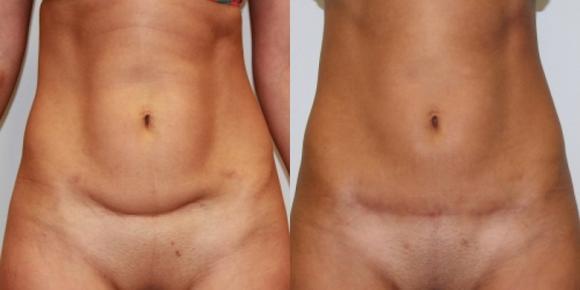
If you add a diet to your exercises and perform other physical exercises, the process of losing weight will go much faster.
Consequences of early training and improper execution
The technique of performing a vacuum for the abdomen involves strong retraction of the abdomen, which leads to stretching of the incision, and this greatly increases the likelihood of the seam coming apart. Despite the fact that the abdomen is pulled “into itself,” the skin is still stretched.
If a woman does not take into account the doctor’s recommendations and prescriptions and starts doing exercises incorrectly or too early, then the following are possible:
- divergence of sutures - internal on the uterus and external on the skin;
- formation of a keloid scar on the seam due to its overstretching;
- development of the inflammatory process at the incision site;
- the formation of foci with purulent contents - if this occurs in the area of the internal suture, then additional surgical intervention will be performed.
We recommend reading the article about what exercises you can do after a cesarean section. From it you will learn how long after a CS you can start training, permitted and prohibited exercises, as well as contraindications to training. And here is more information about when you can pump up your abs after a caesarean section.
A vacuum for the abdomen after cesarean section, provided that the exercise is performed with the permission of a doctor, will be effective and safe. The lesson takes only a few seconds, and strengthening of the abdominal muscles and tightening of the skin will be noticeable within 6 months.
Possible contraindications
After pregnancy, it is forbidden to practice deep breathing if you have the following diseases:
- exacerbation of colitis, gastroduodenitis, gastritis;
- the presence of a peptic ulcer of the intestines or stomach;
- pancreatitis and cholecystitis;
- thrombosis;
- ischemia;
- pyelonephritis;
- lung diseases;
- heart defects.
You should discuss the possibility of exercise with your doctor if you have unexplained bleeding.
An absolute ban on exercises with vacuum breathing is imposed in cases where a woman has a uterine rupture or has any postpartum injuries.
Useful video
Watch the video about using vacuum for diastasis:
Similar articles
- How to get rid of the belly after a cesarean section: home methods...
The main ways to get rid of the belly after a cesarean section, if it is large. How long does it take to recover, is it possible to lie on your stomach. How to get rid of and lose weight with a roller, wraps, vacuum. Popular abdominal surgeries after caesarean section. Read more - When can you pump up your abs after a cesarean section, after how long...
What to consider when choosing the timing of when you can pump up your abs after a caesarean section. After what period of time is it possible if there were complications. How to start training correctly. How to restore your stomach and abs after childbirth through cesarean. Read more
- Spinal anesthesia for caesarean section: how...
How spinal anesthesia is performed during caesarean section, complications and consequences after it for the woman and child. Which anesthesia is better for a CS - epidural, general. Contraindications to spinal anesthesia. How long does anesthesia last, how long does it take to wear off? How does a woman feel with him? Read more
- How long after cesarean can you exercise...
How to know exactly how long after a cesarean section you can play sports. Why can't you start training right away? What can be included in the exercise program after cesarean and when: plank, aerobics, swimming pool, exercise equipment, running, squats, strength training, yoga, fitness. Read more
- Exercises after cesarean section: when and how long after...
What exercises can you do after a cesarean section, and how long before you start training. What physical exercises can you do for the first time after weight loss surgery? What is suitable - jump rope, horizontal bar, gymnastics, exercise therapy, Kegel. Read more
Who should I thank?
For a popular exercise that allows you to quickly tighten your tummy after childbirth, you have to thank yogis. It is in their practice that a similar asana is used to help train the abdominal muscles.
However, thanks should also be given to Arnold Schwarzenegger, because it was he who made the vacuum exercise so popular. Being a professional bodybuilder, he willingly included it in his training program in order to then surprise the audience with his “wasp waist.”
https://www.youtube.com/watch?v=S_ckdnpxywA
It is impossible to say with absolute certainty how long it will take for the figure to fully recover, but to get closer to the answer, I recommend reading my separate post on this topic.






